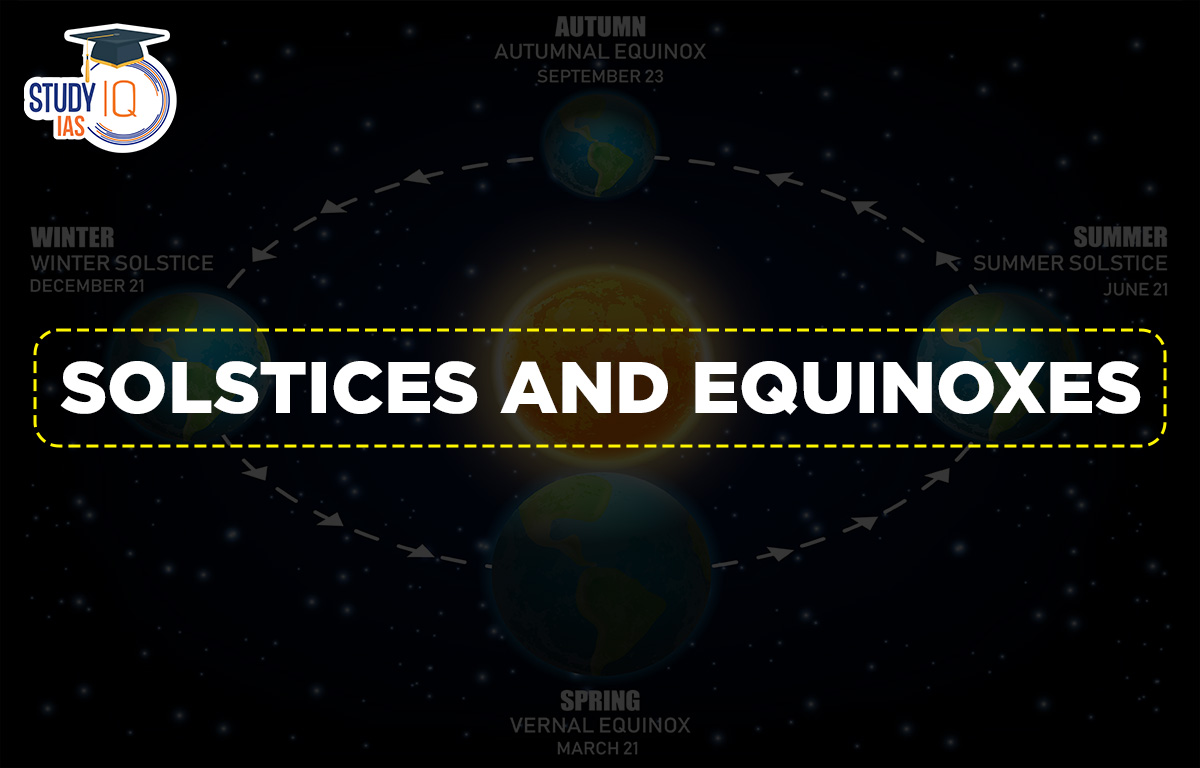Table of Contents
Solstices and Equinoxes Meaning
Solstices and equinoxes are the changing seasons on Earth, but they are opposite to each other. The seasons change because Earth is tilted on its axis as it orbits the Sun. This tilt causes different areas to receive varying amounts of sunlight throughout the year. Without this tilt, the Sun would always be directly above the Equator, and we would not have seasons, equinoxes, or solstices.
The two solstices occur in June (around the 20th or 21st) and December (around the 21st or 22nd). On these days, the Sun is at its farthest north or south point from the Equator. The June solstice marks the start of summer in the Northern Hemisphere, as the North Pole tilts closest to the Sun. The December solstice marks winter when the South Pole is tilted closest to the Sun.
Equinoxes happen in March (around March 21) and September (around September 23). On these days, the Sun is directly over the Equator, making day and night equal in length.
| For the Northern Hemisphere: |
| Vernal Equinox (March 21): Start of spring, equal day and night. Summer Solstice (June 20 or 21): Longest day of the year, start of summer. Autumnal Equinox (September 23): Start of autumn, equal day and night. Winter Solstice (December 21 or 22): Shortest day of the year, start of winter. |
Solstices and Equinoxes Dates
On June 21, the Sun is directly over the Tropic of Cancer, which is the Summer Solstice. This is the longest day of the year in the Northern Hemisphere, and at the Arctic Circle, the Sun doesn’t set at all.
On December 22, the Sun shines directly on the Tropic of Capricorn, which is the Winter Solstice. This is when the South Pole is tilted toward the Sun, and the Sun doesn’t set at the Antarctic Circle.
The Equator receives direct sunlight on March 21 and September 23, when neither pole is tilted toward the Sun. This results in equal day and night everywhere on Earth, known as the equinox. March 21 is the Spring Equinox, and September 23 is the Autumn Equinox.
Equinox Meaning
The Equinox is the time of year when the day and night are equal. This event occurs twice a year. The Dates of Equinox are on March 20 and September 23. An equinox happens when the Earth’s equator lines up directly with the Sun. This means the center of the Sun is directly above the equator.
Vernal Equinox & Autumn Equinox
The vernal equinox occurs in March, marking the start of spring in the Northern Hemisphere, while the autumnal equinox happens in September, marking the start of autumn. In the Southern Hemisphere, these seasons are reversed. During an equinox, the Sun shines equally on both hemispheres, and it appears to rise at one pole and set at the other. This can also disrupt satellite signals for a short time due to the Sun’s position.
Solstices Meaning
The word “solstice” comes from Latin and means “stalled sun.” It happens twice a year in each hemisphere once in summer and once in winter.
- Summer Solstice: This is when a hemisphere gets the most sunlight during the year.
- Winter Solstice: This is when a hemisphere has the least sunlight of the year, except at the equator.
Summer Solstice & Winter Solstice
The Summer Solstice occurs on June 21 and the Winter Solstice is on December 21. These dates help define seasons in many countries.
- During the June solstice, the Sun is at its highest point for observers at the North Pole, while in December it is highest for those at the South Pole.
- The solstices mark the longest day (summer) and the shortest day (winter) of the year. The Sun is most intense at 23.5° north in June and 23.5° south in December due to Earth’s tilt of 23.5°. Many cultures have celebrated the winter solstice as a time of change and renewal.
Solstice Geography Behind
The tilt of the Earth causes the lengths of days to change. Earth’s axis is tilted at 23.5° which affects how much sunlight different places get.
- For half the year, the Northern Hemisphere tilts toward the Sun, leading to long summer days. For the other half, it tilts away, making days shorter.
- This tilt also creates the seasons as the Sun moves between the northern and southern hemispheres throughout the year.
Difference Between Solstices and Equinoxes
The below table shows you the difference between Solstices and Equinoxes:
| Solstices | Equinoxes |
| The sun is far from the equatorial plane. | The sun is close to the equatorial plane during the equinox. |
| Long days or nights are observed during the Solstice. | The length of day and night is equal during the equinox. |
| It occurs twice a year. | It occurs twice a year. |
| It happens in the winter and summer. | It occurs at the start of the fall and spring seasons. |
| The solstices occur on June 21 and December 22. | The equinox occurs twice a year, on March 20 and September 22. |
Solstices and Equinoxes UPSC
The equinox and solstice are astronomical landmarks. During the equinox, the earth is either directly beneath or directly above the sun. The solstice occurs when the sun is at its highest point away from the Earth. Solstice is a significant event for farmers because it marks the beginning of the growing season.
This topic holds immense importance for the UPSC CSE examination and every aspirant should be well-prepared in this particular area.


 Role of Teachers in Educations, Student ...
Role of Teachers in Educations, Student ...
 India's achievements after 75 years of I...
India's achievements after 75 years of I...
 Bal Gangadhar Tilak Biography, Achieveme...
Bal Gangadhar Tilak Biography, Achieveme...

























